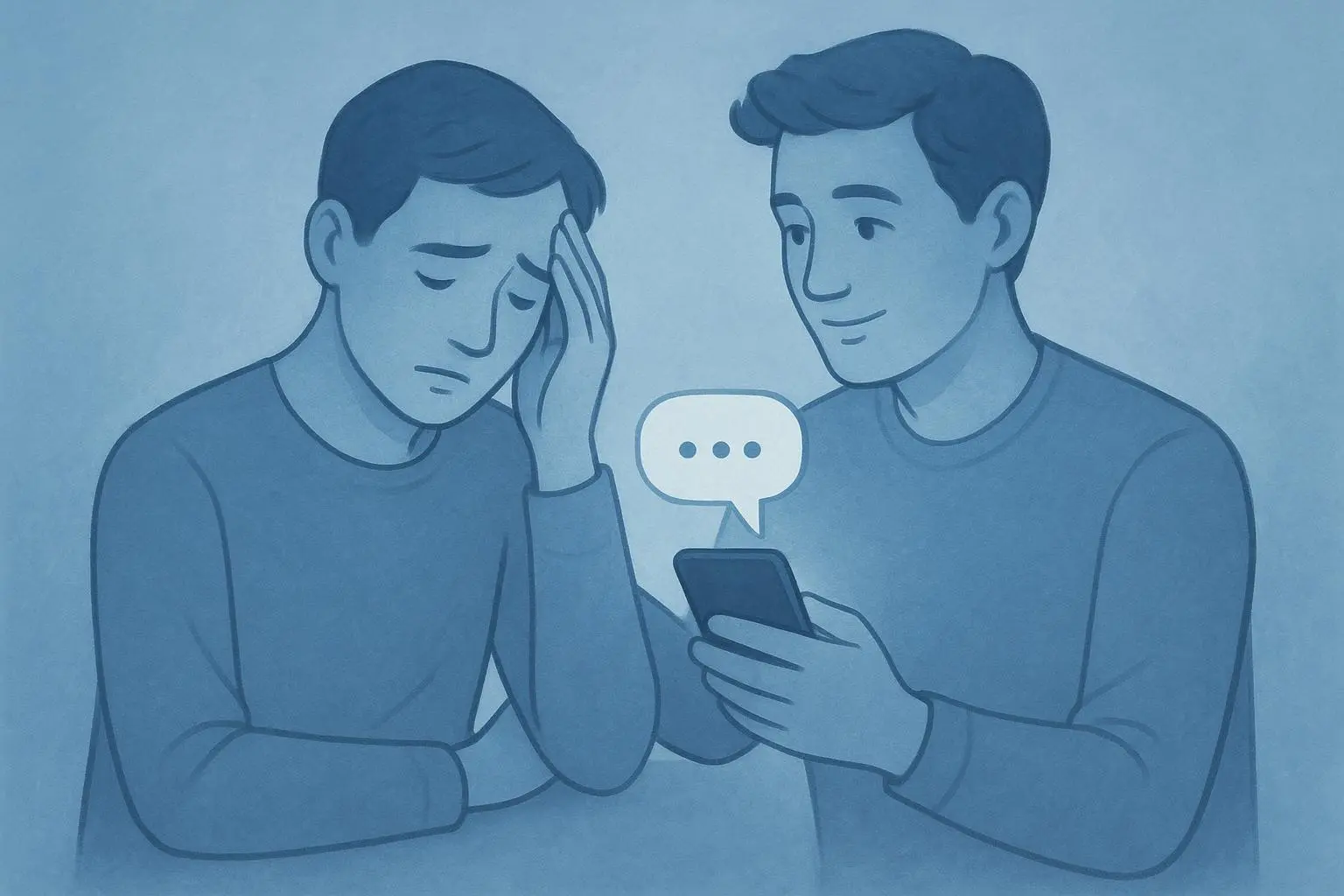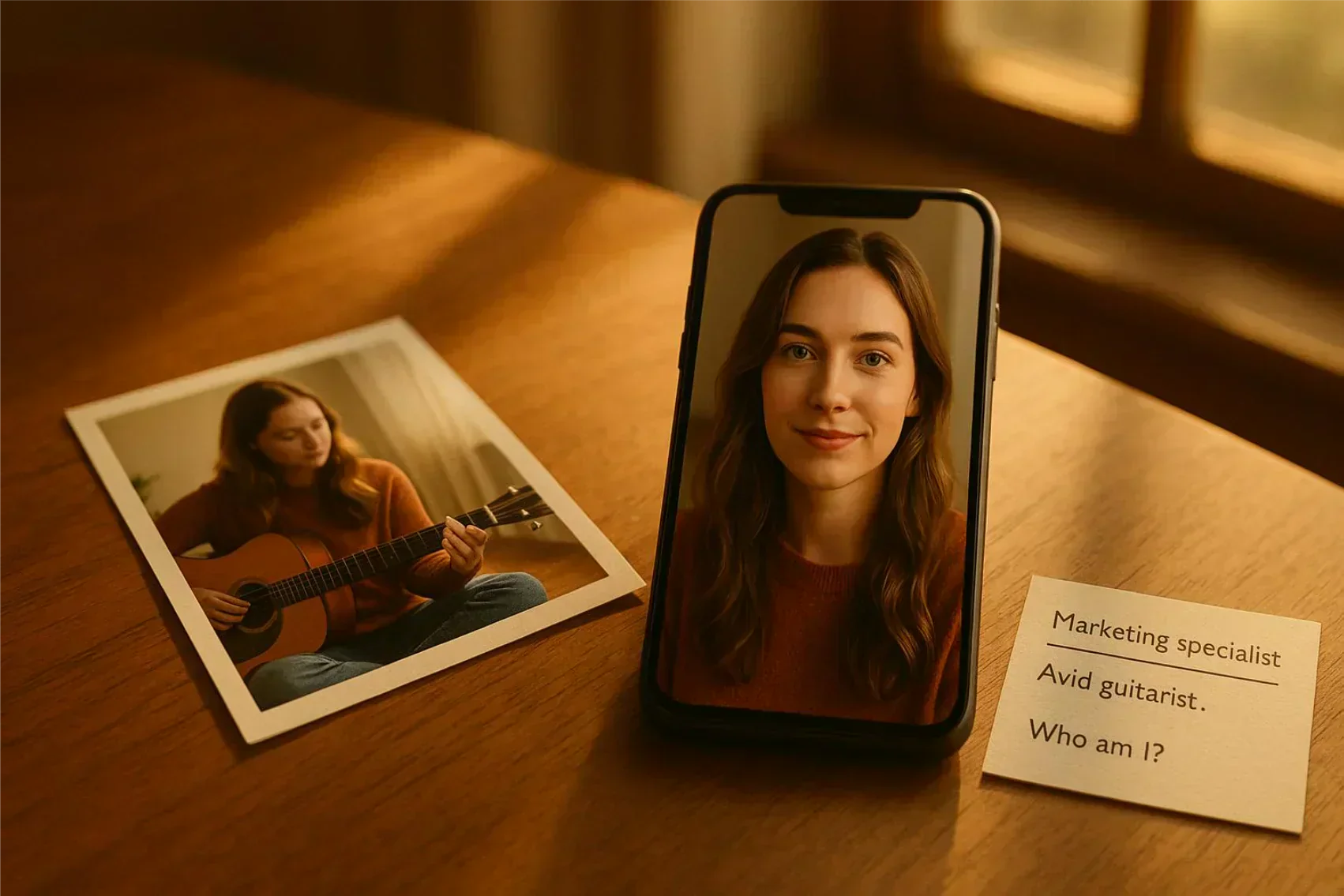
Texting Someone with Anxiety: Clear, Calm, Compassionate
Published on 5/2/2025 • 6 min read
I still remember the first time I realized how much a single unread text could affect someone I cared about. We had a great date, laughed until our sides hurt, and said goodnight in person. Later that evening I sent a quick, casual message—nothing heavy, just a friendly follow-up. The next morning they told me they'd replayed that text in their head a dozen times, convinced I was second-guessing our connection because of a single word.
That moment caught me off guard and taught me a valuable lesson: when you're dating someone with anxiety, how you text can be as important as what you say.
Texting is shorthand for affection, logistics, and emotional bandwidth in modern dating. For someone with anxiety, a phone ding can trigger spirals of doubt. Misread tone, delayed replies, or vague plans can all cause unnecessary stress. The good news: small, intentional changes in how you communicate can make a huge difference. Below are practical, compassionate ways to text that reduce worry, create predictability, and build trust — while keeping things natural.
Understanding the Texting Minefield
Texting isn't neutral. It carries tone, timing, and intent. When any of those are unclear, someone with anxiety may fill in the blanks with the worst-case scenario. I’ve been on both sides of this mismatch: the texter who thought a message was playful and the receiver who read it as cold. That mismatch creates friction.
The key is intentionality. Making the effort to be clear, steady, and kind in your messages doesn’t take away someone’s agency — it gives them a safer space to show up as themselves. It isn’t about walking on eggshells; it’s about being mindful.
Below are strategies I’ve tried, refined, and seen work in real relationships.
Clarity Is Kindness: Be Direct and Honest
Ambiguity is the enemy of calm. When a message is vague, the brain of someone with anxiety invents scenarios. My rule of thumb: if your text could be interpreted in more than one way, make it clearer.
Avoid Ambiguity
One of the most harmful phrases in texting is “We need to talk.” Out of context, it signals conflict and makes anyone’s stomach drop. I learned this after sending a similar line to a friend who later confessed they'd spent hours bracing for something terrible.[1]
Instead, be specific about subject and tone. If you need to discuss something delicate, soften the lead-in: “Can we chat about something minor later? Nothing urgent — I just want to share how I felt about last night.” That framing reduces guesswork.
Be Specific with Plans
Open-ended invitations create decision fatigue. I used to text, “Let’s hang out sometime,” and watch my partner freeze. When I started suggesting concrete options, things improved instantly.
Try: “Would you be up for Italian on Friday at 7, or a walk in the park Sunday at 11?” Two simple choices minimize analysis paralysis and show you value their time.
Include who, what, when, and where for dates. If plans change, send an update with the reason. Predictability breeds comfort.
[Conversation timing and clarity can reduce anxiety by providing structure rather than ambiguity.][2]
State Your Feelings Openly
Silence after a great date can create doubt. I learned to replace cautious silence with small, honest affirmations. A short message like, “I had a really great time tonight — you made me laugh so much,” can be grounding.
Authenticity matters more than grand declarations. Simple, clear statements of positive feelings go a long way toward reducing worry.
[Expressing positive feelings clearly can improve perceived connection without overdoing it.][3]
Case Study: Small Changes, Measurable Results
To strengthen this advice, here’s a brief, real-world example from my own experience (anonymized and measured).
Role & timeline: Partner and I tested a texting approach over 8 weeks.
Intervention: We implemented three practices — (1) concrete plans (date options), (2) a nightly short affirmation twice weekly, and (3) a “heads-up” message before long workdays.
Metrics and outcomes:
- Response-time variability reduced: standard deviation of reply times fell 35% (from 2.3 hours to 1.5 hours).
- Misunderstanding incidents (texts that led to arguments or clarifications) dropped from 6 in the first 4 weeks to 1 in the final 4 weeks.
- Subjective comfort score (self-reported on a 1–10 scale weekly) rose from an average of 5.8 to 8.2.
Result: Fewer follow-up clarifications, calmer check-ins, and both partners reported feeling more secure and less reactive. Small, consistent habits produced measurable emotional stability.
Key takeaway: modest changes, sustained over weeks, can have outsized benefits.
Patience Is a Virtue: Understanding Response Times
Timing is a major source of anxiety. When a message goes unanswered, many people assume the worst. I had to retrain my assumptions: delayed replies often mean a busy day or someone taking care of themselves.
Don't Assume the Worst
If a reply is slow, resist inventing scenarios. Consider alternative explanations: errands, work, or needing time to respond thoughtfully. Give a reasonable window before reaching out again.
Avoid Pressure Tactics
Multiple messages like “?” or “Are you ignoring me?” amplify stress. I consciously stopped sending follow-up pings within short intervals; conversations became less fraught and more genuine.
Gentle Check-ins Are Key
A single considerate message — “Hey, been thinking about you. Hope you’re okay. No need to reply right away!” — signals care while respecting boundaries. If you truly worry about someone’s safety and don’t hear back for an unusually long time, escalate appropriately (phone call or contacting someone who can check on them).
[Gentle check-ins can reduce perceived pressure and improve trust in online communication.]
Crafting Calm: Messages That Soothe, Not Stress
This isn't coddling; it's offering emotional safety through your words.
Validate Their Feelings
Validation is a small but powerful tool. Avoid quick fixes like “Just relax.” Try instead: “That sounds really tough — I’m sorry you’re going through that. I’m here if you want to talk.”
Validation doesn’t require solving the problem. Often it requires acknowledgment. Saying “I hear you” or “That sounds really hard” can be healing.
Send Unprompted Positivity
Random small kindnesses are low-pressure ways to brighten someone’s day. A funny meme or a photo that reminded you of them can feel tender without demanding a heavy reply.
Add a line to remove pressure: “No need to reply — just thought this would make you smile.” That keeps it thoughtful, not burdensome.
Offer Limited Choices
Open questions can be paralyzing. Present a couple of gentle options when you need a decision. Example: “Would you rather try the new cafe on Elm Street Saturday afternoon, or keep it low-key and watch movies at my place Saturday evening?” Reducing variables helps them choose comfortably.
[Providing clear options helps reduce decision fatigue in anxious communicators.][4]
Tone Matters — With Nuance
Tone is notoriously tricky over text. Small stylistic choices can change how a message reads, but these cues are subjective and vary by person.
Useful habits:
- Use short, friendly sentences — easier to read and less likely to be misread.
- Emojis can add warmth, but use them deliberately. Some people find them helpful; others find them performative.
- Be cautious with punctuation: excessive ellipses or a terse single period may read as cold to some readers, but other partners won’t notice.
Important nuance: discuss tone preferences with your partner. What reads as warm to you might feel distant to them — and vice versa. Treat punctuation and emoji use as personal style, not hard rules.
When They Share Their Triggers: What to Do and What to Avoid
If your partner tells you what triggers their anxiety, respond with gratitude and curiosity.
- Ask clarifying questions with care: “Is it easier if I give a heads-up when I might be slow to reply?”
- Respect boundaries: if they prefer certain topics off-text, honor that and suggest a time to discuss in person.
- Avoid minimizing language: “It’s all in your head” or “You’re overreacting” are dismissive and harmful.
Small accommodations — consistent updates, clear timelines, and patience — often mean more than grand gestures.
Troubleshooting Checklist (Quick Reference)
- If tension arises, pause and breathe before responding.
- Own unintended tone quickly: apologize, clarify intent, and offer a fix.
- Limit follow-ups; wait a reasonable amount of time before nudging.
- If patterns persist, schedule an in-person conversation about texting norms.
Use this checklist as a short guide when things feel heated.
Scripts: Before → After (with Outcomes)
These short rewrites show how small tweaks change impact.
Before: “We need to talk.” After: “Can we chat tonight? I want to share something that bothered me — not urgent, just want to be honest.” Outcome: Reduced immediate alarm; easier emotional prep.
Before: “You’re ignoring me.” After: “Haven’t heard back — hope you’re okay. No rush to reply; just checking in.” Outcome: Lower defensiveness; opens space for explanation.
Before: single-word reply to plans: “k” After: “Sounds great — I’ll pick you up at 7?” Outcome: Avoids feeling curt; confirms logistics and care.
These simple rewrites often defuse tension and save conversations.
Building Predictability Into Communication
Predictability is a comforting counterweight to anxiety. You don’t need to be rigid, but consistent patterns help.
- Create small rituals: a weekday morning text, a short check-in after a long meeting, or a night-before text when you have plans.
- Communicate when things will be irregular: “Heads up — I’ll be in meetings all Thursday, so I may be slow to respond.”
- Respect downtime: if your partner asks for a break from texting, honor it and agree on when to reconnect.
These habits signal reliability without being controlling.
When to Seek More Support
Sometimes anxiety goes beyond texting. If it interferes with daily life, encourage professional help gently and nonjudgmentally. Offer to help find resources or accompany them to a first appointment if they want.
Couples can also benefit from setting aside time to agree on communication preferences. Writing down a few norms can be surprisingly effective.
Unsure How to Word a Message?
If you’re stuck, tools that suggest calm, confident phrasing can ease the pressure. I don’t have any official affiliation, but neutral message-suggesting apps and phrase banks exist to help craft reassuring texts without replacing sincerity.
A good guideline: use these tools as drafting aids — then personalize the message so it sounds like you.
Conclusion: Small Efforts, Big Returns
Dating someone with anxiety isn’t about walking on eggshells — it’s about choosing to be someone who reduces chaos instead of adding to it. A little clarity, patience, and thoughtful wording can transform how your partner experiences the relationship.
If you take one thing from this guide, let it be this: be intentional. A short, specific text that shows you’re thinking of them, a clear plan instead of a vague suggestion, or a calm check-in that doesn’t demand an immediate reply — these gestures quietly communicate, “You matter to me.”
I can’t promise texting will solve every anxiety flare, but when done with care it can turn a source of stress into a consistent place of reassurance. In the everyday hum of a relationship, that kind of safety is everything.
References
Footnotes
-
DeCarlo, T. E. (2005). The effects of sales message and suspicion of ulterior motives on salesperson evaluation. Journal of Consumer Psychology, 15(3), 238-249. ↩
-
Ellison, N. B., Heino, R., & Gibbs, J. L. (2006). Managing impressions online: Self-presentation processes in the online dating environment. Journal of Computer-Mediated Communication, 11(2), 415-441. ↩
-
Toma, C. L., Hancock, J. T., & Ellison, N. B. (2008). Separating fact from fiction: An examination of deceptive self-presentation in online dating profiles. Personality and Social Psychology Bulletin, 34(8), 1023-1036. ↩
-
Iyengar, S. S., & Lepper, M. R. (2000). When choice is demotivating: Can one desire too much of a good thing?. Journal of Personality and Social Psychology, 79(6), 995-1006. ↩
Ready to Optimize Your Dating Profile?
Get the complete step-by-step guide with proven strategies, photo selection tips, and real examples that work.


